Wildlife photographer Laurie Campbell explains how to set up a hide to photograph wildlife.
What to consider when buying a hide
Portable fabric hides come in various guises and are freestanding, lightweight and quick to deploy. Choose one that is showerproof, of a colour matching the habitat in which you will be using it, and made from material heavy enough that your silhouette won’t be seen when the sun is behind you.
You should also be able to secure it to the ground so that it won’t flap around. But the main thing is that your shelter is large and comfortable enough for you to spend a lot of time in there: the longer you wait, the more you will see.
How Laurie set up a seashore hide
Step 1 I wanted to introduce a temporary hide to the edge of this sea loch on the Isle of Skye that I could use to photograph shorebirds. To decide on the location, I sat with the equipment I would be using to check range, perspective and lighting, then put the hide at the foot of a bank and beneath the skyline.

Step 2 I added the canvas cover over the free-standing frame of the hide, then put stones in pockets sewn inside the hem along the bottom. These would keep the fabric stable and improve its waterproof qualities. I also moved a few rocks into position around the hide to reduce its profile in the landscape.

Step 3 Lastly I added scrim netting and seaweed that I found cast up on the upper shore. This amount of camouflage is rarely needed solely for the animals’ sake, but another reason I use it is to conceal my hides from the public so I can avoid unwanted attention and disturbance.

